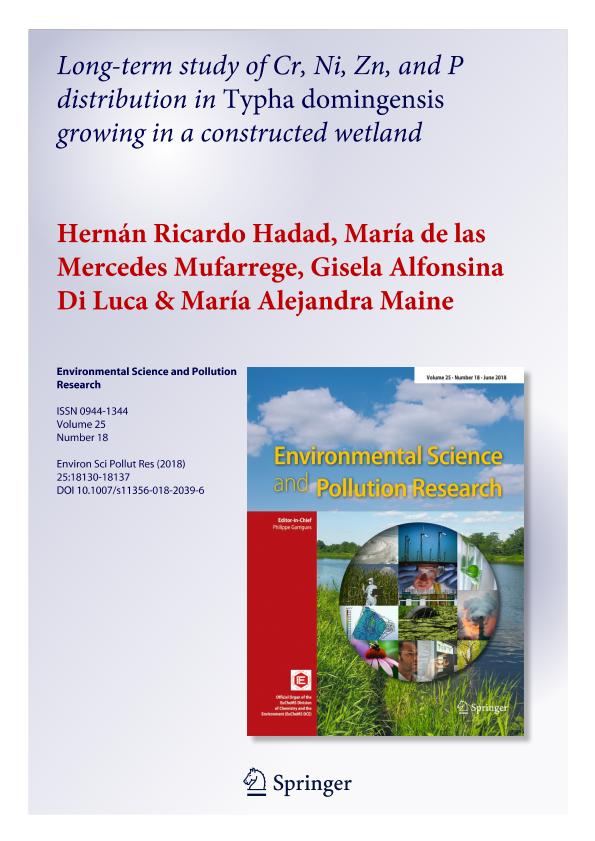Artículo
Long-term study of Cr, Ni, Zn, and P distribution in Typha domingensis growing in a constructed wetland
Hadad, Hernán Ricardo ; Mufarrege, María de Las Mercedes
; Mufarrege, María de Las Mercedes ; Di Luca, Gisela Alfonsina
; Di Luca, Gisela Alfonsina ; Maine, Maria Alejandra
; Maine, Maria Alejandra
 ; Mufarrege, María de Las Mercedes
; Mufarrege, María de Las Mercedes ; Di Luca, Gisela Alfonsina
; Di Luca, Gisela Alfonsina ; Maine, Maria Alejandra
; Maine, Maria Alejandra
Fecha de publicación:
06/2018
Editorial:
Springer Heidelberg
Revista:
Environmental Science and Pollution Research
ISSN:
0944-1344
e-ISSN:
1614-7499
Idioma:
Inglés
Tipo de recurso:
Artículo publicado
Clasificación temática:
Resumen
The aim of this work was to study Cr, Ni, Zn, and P bioaccumulation in different compartments of Typha domingensis plants and sediment in a free-water surface constructed wetland for the treatment of a metallurgical effluent for 5 years. Removal efficiencies were satisfactory. To increase metal tolerance, its transport from belowground to aboveground tissues is reduced, being metal concentrations in the roots and rhizomes significantly higher than in the aerial and submerged parts of leaves. Regarding belowground tissues, metals were retained in the roots, while P was mainly accumulated in rhizomes. Bioaccumulation factors (BAFs) of Cr and Ni showed values near 1, and BAF of Zn and P were above 1 in several samplings, indicating bioaccumulation in the roots. Translocation factors (TFs) of Cr, Ni, and Zn were below 1, showing a scarce translocation from the roots to the aerial parts of the leaves, while the TF of P were above 1 in many samplings, indicating that this element is necessary for plant metabolism. The study of plant tissues where contaminants are accumulated allows gaining insight into the constructed wetland operation. The high translocation of P in T. domingensis makes this species suitable for its phytoextraction, while the low metal translocation makes T. domingensis suitable for phytostabilization.
Palabras clave:
INDUSTRIAL EFFLUENT
,
MACROPHYTES
,
METALS
,
PHOSPHOROUS
,
TISSUES
Archivos asociados
Licencia
Identificadores
Colecciones
Articulos(IQAL)
Articulos de INSTITUTO DE QUIMICA APLICADA DEL LITORAL
Articulos de INSTITUTO DE QUIMICA APLICADA DEL LITORAL
Citación
Hadad, Hernán Ricardo; Mufarrege, María de Las Mercedes; Di Luca, Gisela Alfonsina; Maine, Maria Alejandra; Long-term study of Cr, Ni, Zn, and P distribution in Typha domingensis growing in a constructed wetland; Springer Heidelberg; Environmental Science and Pollution Research; 25; 18; 6-2018; 18130-18137
Compartir
Altmétricas



